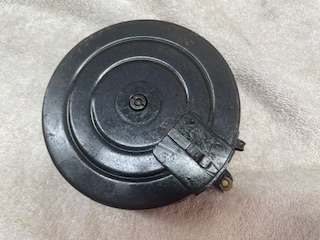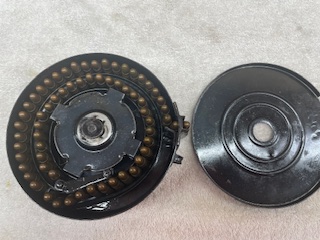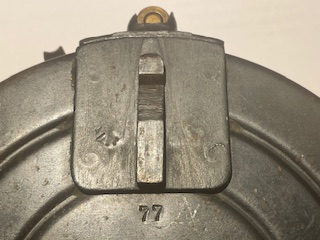|
|
13 registered (harley, ZM3L8R, WGSIG, shoot2kill, wdc757, Too, Brud Carey, losingle, Groundhog33, pgraber, Jake3, 2 invisible),
25
Guests and
5
Spiders online. |
|
Key:
Admin,
Global Mod,
Mod
|
|
#2094865 - 02/13/24 12:04 PM
 Tokarev 7.62x25mm Sub Gun Drum Mag w/63 original rounds - $95. 00 FOB Culpeper
Tokarev 7.62x25mm Sub Gun Drum Mag w/63 original rounds - $95. 00 FOB Culpeper
|
Echo13

Pea shooter
Registered: 01/23/24
Posts: 5
Loc: Virginia
City or County: Culpeper
|
NEW PRICE! Contact: prc_rac@comcast.net
Tokarev 7.62 x 25mm PPSH-41 Drum Magazine (w/63 rounds) for Tokarev Submachine Gun
Situation: It was mid-September 1967. I was a 2Lt, having been commissioned from Army Engineer Officer Candidate School on 2 June 67. I was ordered to the Republic of Korea where I was subsequently assigned as a Platoon Leader with Bravo Co, 13th Engineer Bn (Combat), 7th ID. I was detailed to the 2nd ID operating area within the DMZ to build part of the “Barrier Fence”.
Explanation: North Korea was, and had been for quite some time, aggressively sending infiltrators and saboteurs across the DMZ to raise havoc in the south, among the civilian population especially. Rapes, murders, fire bombings, kidnappings, killings of livestock, etc. were the order of the day. The objective of these efforts was to apply political pressure to the So. Korean government to order their two infantry divisions out of Vietnam and bring them home to secure the homeland.
If this were to happen the US would have to supply two more fighting divisions to the war effort which would have been an explosive political problem to the US Administration and fuel for the ongoing loud and angry anti-war protest movement.
The Barrier Fence was a “negotiated settlement” between US Pres. Lyndon Johnson and So. Korean Pres. Park Chung Hee. Its function was to slow down/stop the flow of infiltrators and saboteurs into So Korea easing the feelings of insecurity among the South Korean populace.
The So Korean government would leave their two highly respected, tough, take no prisoners, infantry divisions in South Vietnam to fight on the side of the US if the US would build a Barrier Fence (we called it Lyndon’s Maginot Line) across ~28 miles of the southern border of the DMZ.
FYI – The DMZ is 2000 meters wide. The 38th parallel runs exactly down the center. The center 1000 meters (500 meters either side of the 38th parallel) is a free fire zone. Troops from the North or South have no freedom to be in this area at all. The area is heavily surveiled and both sides register artillery on anything that moves 24/7.
The Northern 500 meters belongs to the North Koreans. They are free to do whatever they wish in it at any time – sow mine fields, dig tunnel entrances, etc. Lets call it the Northern Free Movem ent Zone.
The Southern 500 meter strip belongs to the South Koreans and their Allies. Call it the Southern Free Movement Zone. The Barrier Fence is built along the boundry between the southern edge of the free fire zone and the north edge of the free movement zone.
Events: How I came to own a Tokarev PPSH-41 Soviet sub machine gun drum magazine. Taken from the body of a very recently deceased North Korean soldier.
Location: In the “free fire zone – center 1000m” of the DMZ between North and South Korea approximately 1.3 klicks East and 0.3 klicks south of the JSA (Joint Security Area/Peace Village at Panmunjom on 17 September 1967 following an attack on 2nd Platoon, Bravo Co, 13th Engineer Bn who, at that time, were engaged in building a 1000-meter section of the “Barrier Fence”.
As Platoon Leader, 2nd Platoon, I was the OIC and responsible for building a section of fence and, should it become necessary, defending against any enemy aggression, securing my men and equipment, and otherwise fulfilling the requirements of my mission.
The NK infantryman from whom I removed a PPSH with a near full drum of ammunition, had the poor judgment to snipe at me from behind at close range and miss with what was probably the last round in his magazine. It’s not easy, I imagine, to keep track of how many rounds you’ve fired from a 65 round drum magazine. The tendency would be to run it empty and be really quick at changing to a full mag. The PPSH – 41 is legendary for its extreme reliability and reasonable accuracy at close range. It is my great good fortune that this guy missed – with probably the last round in his magazine. I heard the shot and the bullet buzz past me. When I turned I saw a **I'M AN IDIOT** hurriedly changing magazines
The M-14 is highly regarded for its accuracy and reliability! It was SOP for us to have full magazines and a round in the chamber at all times. We were under attack so the rest came naturally. Afterwards I was able to claim a reasonably well-kept Tokarev PPSH-41 with a nearly full drum magazine as a souvenir. I cleaned it, layered it with cosmoline, and stashed it in the bottom of my foot locker where it stayed until July ’68 when I packed my hold baggage for shipment home (by ship, train, etc).
I had been home for nearly a month when my hold baggage finally arrived at my girlfriends (now my wife of 54 years) home. I couldn’t wait to see if my souvenir had made it. As soon as the box rolled off the truck I could see that it had been opened. Sure enough the submachine gun was gone but they left me with the drum magazine.
PRC
CAPT., CE
Attachments
  
|
|
Top
|
|
|
|